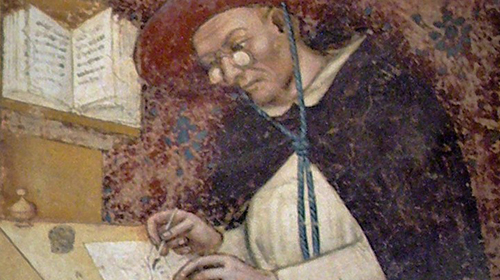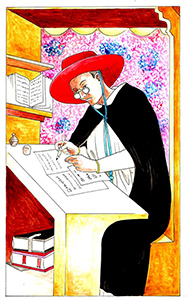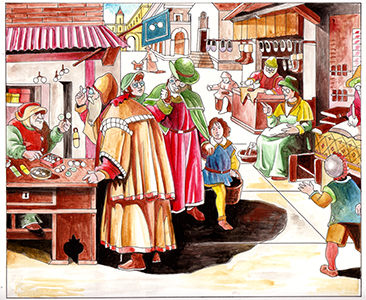History of glasses

Millions of people, every day, wear glasses and lead a completely normal life. An invention so simple and so important that for many centuries has improved the quality of our life.
The Professor Spencer M. Di Scala, the great American historian, wrote: "The 'art of making a pair of glasses is a monumental importance to the' humanity, which has had an incalculable impact, although it is sco nized to the general public, the evolution and development of eyeglasses over the past seven centuries qualifies as a fascinating journey through history, whose development deserves to be better known and appreciated ". Without the invention of glasses, science, custom, art would not have led to the evolution of our civilization.
We do not know precisely when we should attribute the birth of eyewear, certainly it is that age Lucio Anneo Seneca ( Cordova , 4 BC Rome , 65 d. C. ) scfights: "The letters, even small and confused, appear enlarged and clear through a glass globe full of water ". It is said that Nero used an emerald as a monocle to better observe the duels of the gladiators, perhaps because the green color of the stone had a restful effect on the eyes or because the particular cut of his stone allowed him, perhaps without knowing it, to correct a vision defect. It was however a very imitated habit and " the eyewear" of Nero passed into history. The first representation of eyewear in the history of art is from the year 1352. The work is a fresco made by the artist Tommaso Barisini , better known asTommaso da Modena (1326-1379). In the fresco the eyewear is worn by the Dominican friar Ugo di Saint-Cher. Thomas made this fresco in the Chapter Hall of the convent of San Nicolò in Treviso.
The first representation of eyewear in the history of art is from the year 1352. The work is a fresco made by the artist Tommaso Barisini , better known asTommaso da Modena (1326-1379). In the fresco the eyewear is worn by the Dominican friar Ugo di Saint-Cher. Thomas made this fresco in the Chapter Hall of the convent of San Nicolò in Treviso.
"Every vision takes place by refraction" from the Latin " O mne visio fit refracte ". F u This is the outcome of the translation, by the Polish monacoVitellione, who introduced around 1230 the optical studies of al-Hasan ibn al- simplified Haytham in Alhazen ; He was born in Mesopotamia, near Basra around the year 965 to finish his life as a scientist at the Cario in 1039. He moved very young to the Egyptian capital , called by the young caliph Al- Hakim. He translated and studied the works of Ptolemy and Euclid.
Alhazen discovered that the light travels in a straight line and that making it enter a very narrow opening, gives us a clear view of the external images: it is the operation of the darkroom . Alhazen talks about light, eye and vision, knows the magnifying effect of spherical lenses but without deducing the possibility of practical applications to remedy the defects of sight closely. Subsequently, the abbot Francesco Mauriloco da Messina (1494-1575) re-evaluated the habits of Alhazen by perfecting them; these last ones served to Kepler to signal the modern optics.
The precise location of the invention of eyewear is very ince rta, it is thought to date back to the end of the XIII century in Tuscany. The first paternity of the invention was attributed to Salvino Armato degli Armati , who seems to have been born and lived in Florence between 1258 and 1317, even if there are no documents of the era that can confirm it.
23 February of 1306. In the Church of Santa Maria Novella in Florence, during the sermon, the friar Beato Giordano da Rivalto refers to the invention of the eyes and says he has met the man to whom this invention is owed. Unfortunately he does not mention him. In terms of dating it refers to twenty years before, that's why the invention of eyewear dates back to 1286. It should be noted that Brother Giordano was a confrere with Alessandro Spina. TheDominican friar Alessandro Spina , born and lived in Pisa (12386-1313), skilled cop and ta, very ingenious, he would embrace the inventor of glasses. An 'important witness is in a Latin Chronicle, as oscritta in parchment, for the' 1313 years in M onastero Dominican Santa Caterina D 'Alessandria in Pisa and precisamen you in step 16, which presents the' eulogy of monaco Alessandro Spina. There is praise the manual skills of the plug and it is emphasized that he would see the little glasses after their invention, and that they had, cleverly cop hiatuses. It is further stated that the inventor kept the manufacturing method secret. But this chronicle , according to Edward Rosen , historian of the early twentieth century, had been erroneously transcribed by the doctor, biologist and literary Francesco Redi (Arezzo 1626-Pisa 1697) at the end of the eighteenth century, with the result that the invention of the precious object was attributed to Spina himself. What certain that these two lenses hiuse in a nasal frame ( occulis de vitro cum capsule ) were a discovery of the artisans and not the result of official science; in fact , philosophers and mathematicians were skeptical about it.
The first spectacle lenses were made of rock crystal or beryl, the word Brillen remained in fact the name of the lenses in Germany; the French called themBèricles and Bèsicles . The spread of glasses in the known world was thanks to the first Jesuit missionaries and Venetian merchants. Up until 1300 glasses were made exclusively with convex lenses (positive), they were used in senile age to compensate for presbyopia "for near" or a slight hypermetropia "for far" also called foresight, a defect in some elderly subjects . We had to wait for the first half of the 1400s to solve the visual problems related to the myopic defect, they began research on concave lenses (negative), necessary for correction of myopia, even if it seemed there was a particular need to show well in the distance.
Inventor of myopia lenses (divergent) was Niccolò di Cusa (Nicola Cusano), born in Kues in 1401, died in To di in August 1464. He began his studies in Germany and ended them in Padua. Divine theologian then c ardinal, in 1444 he became interested in astronomy elaborating theories on the still valid universe . The first user of lenses for myopia, of which we have news, he is the second son of Lorenzo the Magnificent (1475-1492), Giovanni de 'Medici (1475-1521) , future Pope Leo X, seems portrayed in youth by Raffaello Sanzio with a pair of glasses with concave lenses, to improve the sight in the shooting of wild game. The first scientific explanation of how the concave lenses produce beneficial effects on myopia comes 150 years later by the German mathematician Friedrich Johannes Kepler (1571-1630) In the artisan workshops of Florence, in the mid-fifteenth century, centers of research and experimentation were born on the use of ophthalmic lenses that through the exchange between theoretical science and practical application allowed a progressive improvement of the product. The Florentine producers became famous in the known world, for the good quality of the glasses at very convenient prices; between 1413 and 1562, over 52 merchants in glasses were registered in Florence . The cheapest glasses were priced between 6 and 18 Money, the ones with the most worked frames, in gold or silver, were sold to about 1 Ducato, equivalent to 82 Money, considering that a mason earned 17 money a day.
The Florentine producers became famous in the known world, for the good quality of the glasses at very convenient prices; between 1413 and 1562, over 52 merchants in glasses were registered in Florence . The cheapest glasses were priced between 6 and 18 Money, the ones with the most worked frames, in gold or silver, were sold to about 1 Ducato, equivalent to 82 Money, considering that a mason earned 17 money a day.
With the invention of printing and the exponential increase in publishing production that follows the diffusion of the glasses, it receives a great boost.Continued is the search for a better stability of the glasses on the nose in order to carry out activities where the hands are necessary: amanuenses, copyists, engravers and goldsmiths.
In the second half of the fifteenth century, glasses appear to see far away packed with biconcave lenses. The materials used to make the frames are the whalebone, the horn, the tortoise and the leather: the structure is arched and the flexible bridge grips the nose.
The metal torsion spring bridge is also tested, which tightens the circles of the lenses on the sides of the nose, but the use was harassing and unstable: the attempt is a prelude to the later nineteenth-century nose-clip.
In the sixteenth century, the eyewear business expands throughout Europe to the point of requiring the regulation of corporations. From found documents, it appears that in 1462 Francesco Sforza Duke of Milan (1401-1466), he ordered through his ambassador in Florence "three docene of dicti glasses " (three dozen glasses), a dozen for the long view " da zovene " (as a young man), another dozen for the short sight " da vechy " (from old man) and the last " common " for half distance or light hypermetropia. From this order it is noted that at the time the glasses were not used only for the compensation of presbyopia, but also to correct myopia and hypermetropia.
At the beginning of the 1700s glasses were born that were not placed on the nose, but were used by holding them in the hand, called " fassamano " from the French " from face to main " (from the face to the hand). The fassamano became spectacles of the rage, especially in France, to the 'aristocracy and the rich bourgeoisie, accessories for' clothing, both male and female, the elegant and refined ornaments, certainly not very practical, but a habit that linked the need to aesthetics. Despite the prevailing fashion of the Fassamano , we began to understand that to give stability and practicality to the glasses you had to place two side rods, the idea dated 1727 is commonly attributed to the London optician Eduard Scarlett (1677-1743), although it was the first to publicize it, it is not documented that it is its inventor. It seems that the invention of glasses with side arms is attributable to the optical Edoardo Rossella of London between 1714 and 1727, even here there are no documents that can testify. What is certain is that Eduard Scarlet Senior in 1727 was given the great honor of being named "Optician of His Majesty King George II of England".
The invention of bifocal glasses is commonly attributed to the famous American scientist and politician Benjamin Franklin (1706-1790) who described it in a letter in 1785 " When I wear my glasses, I just have to move my eyes up and down, to see clearly both far and near, lenses with the appropriate correction are always available ". Imitating Franklin also the president of the United States Thomas Jefferson (1743-1826), I begin to use bifocal glasses with great satisfaction.
The Venetians have always been at the forefront of eyeglasses development: in 1790 they created glasses with colored lenses , a very intense greenish color, probably for protection from the glare of the sun's rays reflected in the lagoon. We can call them the first sunglasses. As happens today, even then the famous artists were trendy, the playwright Carlo Goldoni (1707-1793) used to wear these glasses so that it became very fashionable to wear glasses with dark green lenses.
CURIOSITY: In Nuremberg, in 1557, a decree was issued under which the shops can sell only glasses produced " on site ", while the imported Venetian products can be sold exclusively on the street. Garzoni da Bagnacavallo, who in 1585, published a curious treatise on trades entitled "The universal square of all professions" in the world, notes that the French glasses were as perfect as the Venetian ones. The glasses are sold throughout Europe especially on the streets, in the streets or in the countryside by street vendors and cost little price. Here are the verses that accompany their goods:
"I have glasses for old women
Monocles that are wonderful
Snake lenses
As for peacocks eyes.
I own it for all uses,
to hide the big noses of the sages
to correct the sight of the madmen,
to make jealousy clairvoyant ".
The Chinese glasses are distinguished from the European ones for the frame with a single piece front without nose padsbecause the characteristic shape of the nose does not allow a secure support.
The glasses are mainly in tortoise: this material, besides being easy to work, was considered precious, as it belonged to long-lived animals and was a good idea for the recipient. Furthermore, the lenses are often made of transparent beryl which gives dignity to the wearer. The development of glass technology brought substantial improvements to the spectacle lens: until then glass for lenses was a sub-product of the production of other sectors of the glass industry, the lenses often contained imperfections and were used to cover impurities.
In the last twenty years of the eighteenth century Pierre Louis Guinard introduces the innovation of stirring the molten glass to improve its homogeneity, moves to Bavaria and since 1805 works closely with the young German scientist Joseph Fraunhofer.
From the middle of the century experiments on contact lenses developed. Starting in 1910, the industrial production of celluloid frames began, but the new material proved highly flammable and the factories that use it suffer numerous fires. The celluloid is therefore abandoned and the use of var acetates is used, a use that still lasts today.

